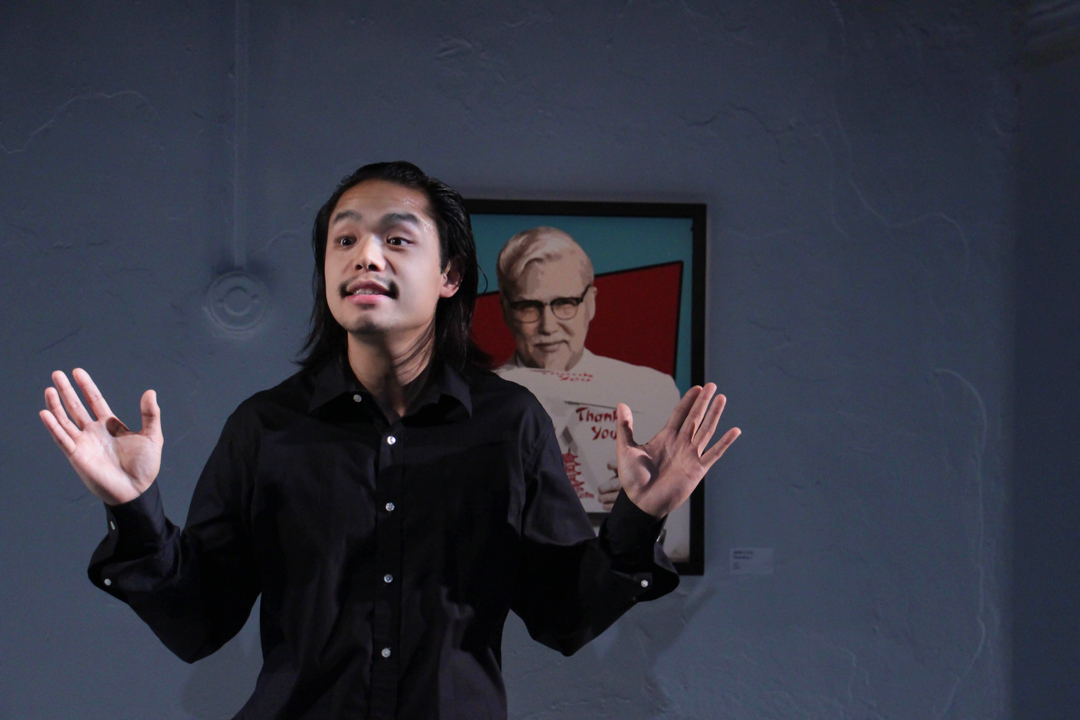
Lin Bo, the Chinese artist whose gallery talk begins “Caught,” declares himself a practitioner of “imaginary art.” State-sponsored galleries in China now exhibit subversive art in a controlled environment as a means of repression. For Bo, the only possible artistic response is to cut out public exhibition entirely. He illustrates this with a description of a piece involving the circulation of a fake logo for a commemorative protest on the anniversary of the Tiananmen Square massacre. The piece specifies no location, and, he imagines, will leave thousands of people glued to their computer screens on the eve of the would-be protest, trying to find out where they are meant to go.
Bo cares about art that strives for “pure reception” and “cuts out the middleman.” He hopes to avoid corrupt exhibitors, but he also believes that any public display runs the risk of ideological contamination. The fake Tiananmen Square protest is ideal because it restricts reception to a truly private sphere, where it might be somehow pure.
“Caught,” directed by Linda Paul, works to contrast the private reception of “imaginary art” with two more formalized settings: the gallery and the theater. Paul places you in both venues simultaneously — the Cab is decorated with paintings and convincing gallery labels. Yang Li, another dissident artist who materializes later, speaks to the incomplete responses of gallery and theater audiences: the theater audience clings to narrative tropes while the art world audience fixates on the visual. Responses to art are conditioned by framing, and expectations tied to venue and genre alter the way we see a piece, change the kind of truth we demand.
Packed with metatheatrical twists and turns, “Caught” plays with the notion of framing, riffing with different genres (theater, performance art, visual art) and aesthetic registers (absurd, realistic, TED talk). By constantly forcing the audience to re-evaluate the relationship between form and content, the play draws attention to the way we demand different kinds of truth based on the kind of work we think we are consuming. The straightforwardly realistic truth of the scene where Bo and Min realize they love the same man, for instance, is different from the “metaphorical” truth of the scene where a sobbing New Yorker editor embraces Bo and congratulates him for recognizing his desire to be white. We can only make sense of this second scene once we have let go of the idea that the characters are real, once we have accepted it is speaking a different language.
In an interview with an exhibitor (which is itself a performance art piece within a performance art piece within a performance art piece within a play), Min suggests that the obsession with finding absolute truth is a capitalistic preoccupation, which she distinguishes from a more “fluid” idea of the purpose of art.
Min’s takedown of the capitalistic obsession with truth parodies a capitalistic reduction of an “Eastern” viewpoint, but it is also a critique with legs to stand on. Destabilizing this underlying obsession with truth is an avowed intention of the playwright, who points to the influence on the play of the Mike Daisey scandal. Daisey, a US monologist, was exposed for exaggerating and embellishing a story about workers at a Chinese factory which produced parts for Apple. Above all, Chen was disturbed by the way the obsession with assigning blame to Daisey allowed people to stop thinking about the exploitation of the workers, which to him seemed like the real problem. Focussing the blame on Daisey amounts for Chen to a pedantic desire to separate artistic and journalistic truths.
For Chen, the remedy to the pedantry of genre-obsession can be found, ultimately, not in imaginary private art but in personal relationships. In a late scene, Wang Min and Lin Bo discuss their relationship to an older activist artist and mentor, Yu Wrong. Now dead, Wrong has inspired both younger artists. As they discuss their opinions of his creative merit, we learn that he has been something very different for each of the younger artists. This is true both on the level of his work and on a more personal level — it seems that Wrong has had romantic relationships with both of his younger colleagues and lied to both of them about it. Here, the question of truth is not mediated by a genre. Wrong’s complexities unfold in a conversation the audience easily relates to, one whose form is less fixed than the play or the gallery talk. The destabilized world of the play looks a lot like a conversation.
Following as it does on a scene that deconstructs the selfishness of gallery exhibition, the unmasking of these Chinese activist artists as basically self-interested allows the audience in the theater something like a sigh of relief. It feels like a negation of Li’s lonely ideal of “imaginary” art. At the same time, it’s a selfishness that must for the first time answer for itself in the unstable language of a real human relationship, an unstable language completely unpalatable to the gallery owner or the magazine editor. Here too, of course, the two artists have only been acting, and we understand what they say on artistic terms. But beneath these surfaces, we are impressed by the suggestion of something that has more to do with life than art.







